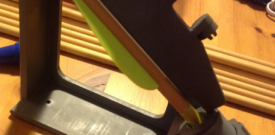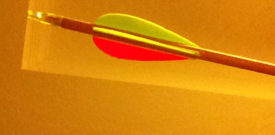I can’t call it ‘traditional’ since I use a Sammick Sage recurve bow, but I do shoot archery, for points, every week with my SCAdian friends down in Santa Ana. I’m not great, I’m decent for a beginner and right now I’m ranked ‘novice.’

Let me explain the ranks. Pretty much every week we shoot Royal Rounds, which is 6 arrows at 40, 30 and 20 yards (untimed) and then ‘as many as you can safely shoot’ in 60 seconds at 20 yards. The average scores of your top three rounds for the year make your rank. I was unranked last year, this year I’m currently at Novice, with the average score of 11 (though I shot 20 on Feb 16th). If my average gets to 25, I become a ‘Bowman’ and at 45 I’m a Yeoman. 65 is Forester, but I have a ways to go.
The points are simple. We use a standard, 60cm, five-color, round target face. The target is scored, from the center, outward, 5, 4, 3, 2, 1. The highest possible score is 90 plus whatever you get on the timed round so the most arrows I’ve seen shot were 8 and if someone hit perfect that would be 130. No one’s scored over a 50 that I’ve personally seen.
Since this is the SCA, we have all sorts of rules like your bow can’t be modern if you want to compete in Period. Most of us don’t do that, though, and we use modern versions of the traditional styles (aka Open Division). But even so, we all use wood arrows. It’s a requirement to use wood, so no ‘wood grain’ metal even though I have seen that. Which brings us to today.
Wood arrows are about $70 for 6 if you buy them pre-made. The wood is the most expensive bit, followed by the feathers and then points and nocks. If you make them on your own, it’s actually less expensive, even if you buy the fletching jig (the holder for the arrows while gluing) and make 24 arrows. We went to FS Discount Archery and they gave us a very fair price, if not the cheapest. Actually it was the cheapest for everything by a considerable amount. $70 less than the next best company I’d seen!
The whole process is actually pretty easy. First you get a pencil sharpener type tool called a tapering tool and ‘sharpen’ each end so one is long and one is short. You glue the nock (the bit around the arrow butt) on the short end and the point (the metal bit) on the long end. We chose to use super glue for the nocks and hot glue for the tips, with the theory of if we break off a tip we can use a hairdryer to heat the wax enough to loosen it and re-use it. That said, we got 36 tips, 100 nocks (you can’t reuse those), and 24 shafts. He threw in a 25th for free, and I’m calling it an Archery’s Double Dozen. Fred, the owner, helped us measure our draw, the arrow length we should use, and the weight. We’d been using arrows that are too long and heavy! Now we’ll have slender, lightweight, but strong.
Next we stained the wood. We use cedar (port orford – the straightest out there), which smells great and put a simple oil finish on it, to make it look golden. At this point you break for lunch to let it dry. We also ran out to get superglue for the feathers. When we got back, the arrows were dry and I went about putting on glue to get the nocks on, while my wife did a second coat of clear oil on hers. Then I did hot-glue to put the tips on, and waited again for that to dry solid. At this point we remembered two things. First, we forgot to measure the shafts and trim off the excess length. Second, I didn’t line up my nocks quite right. Ah well. You’re supposed to make sure the point on the nock lines up with the strongest grain of the wood. I did not do that very well, so I may break my arrows more easily, which will suck, and I have no one to blame but myself.
Finally it was time to fletch!
It took about 90 minutes to do 12 arrows. The method is simple. Wiggle an arrow into the right place on the clamp (we marked ours), draw a line of glue on the flat edge of the feather and carefully let the magnet click into place. Then ease it down until the feather touches the wood. Wait 15 seconds, unclamp, rotate towards yourself, and repeat. It’s three feathers per arrow, and I suspect we could get fast enough to do an arrow a minute, but we took our time.
Now for the price thing. Everything we got today was $215.
That sounds like a lot for 25 arrows ($8.60 per arrow!), but you have to price it the other way. First of all, it will only cost us about $50-75 next time, since we had to buy the jig and feathers and all. Now we have spare feathers (50 per pack, 3 packs, and only 25 per pack used), spare points (we got 36 for 25 arrows), and spare nocks (100 nocks, 25 used). So all we really need would be more shafts and more points. Secondly, and this is the important thing, arrows normally cost between $50 and $100 for six finished wood arrows. That means the cheapest arrows, the ones where you don’t get anything fancy, would be $200 for 24 arrows. We spent $15 more and got to totally customize. We could argue it would be $30 more if we added in the cost of the wood oil, but we’d already bought that for other projects, like our book cases. Finally, aluminum arrows are about $6.25 per arrow, and carbon are about $7.13, but neither come with points ($5 for 12). Custom arrows for metal? About the same as custom for wood.
It’s not like we ‘saved’ money, all told, but there’s a certain thrill in saying “My arrows? Oh, I made them.” And next time I’m going to paint them so they stand out even more!


